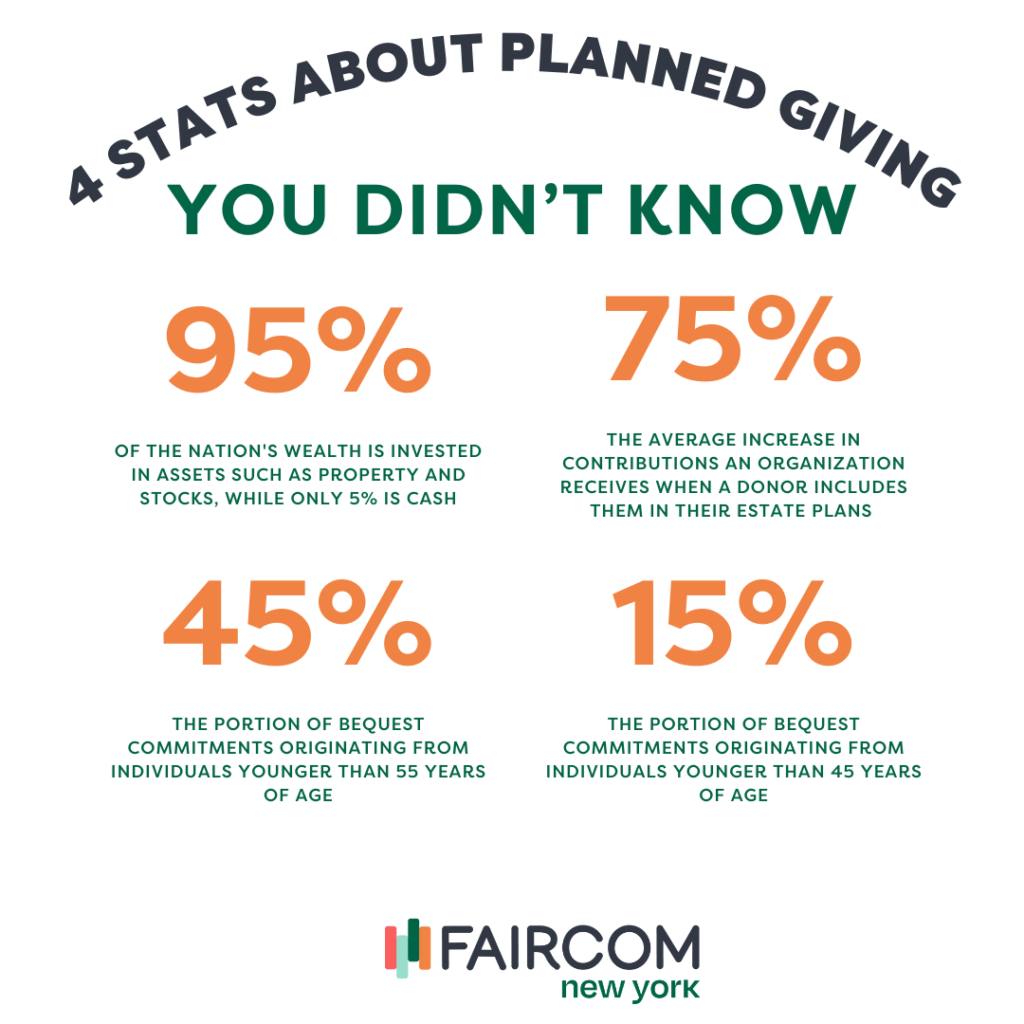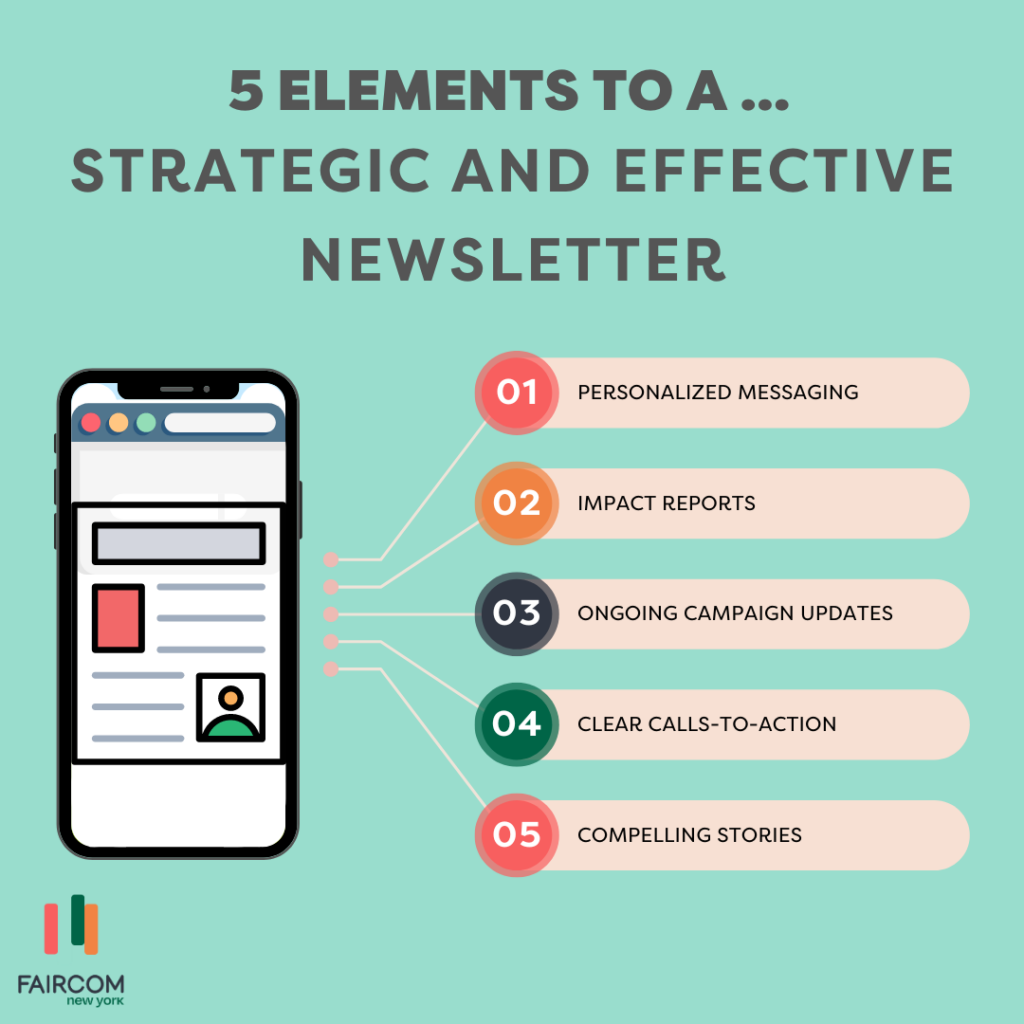Prioritizing planned giving is crucial for nonprofits, as it represents a strategic investment in the organization’s future stability and growth. This foresight ensures the sustainability and resilience of nonprofits, allowing them to continue their mission-critical work well into the future. Yet many organizations may put planned giving investments on hold because these returns won’t be realized until subsequent fiscal years.
This is a pivotal misstep, considering that the vast majority of wealth in the nation is not in liquid form but is held in assets like real estate and securities. By not incorporating a strong emphasis on planned giving, organizations inadvertently leave a significant portion of potential contributions on the table. The beauty of planned giving lies not only in its capacity to secure substantial future funds but also in its ability to forge deeper, lasting relationships with donors who wish to leave a legacy that echoes their values and philanthropic goals.
Taking steps to revamp and prioritize planned giving strategies can serve as a cornerstone for not only securing financial donations but also building a community of committed supporters. This strategic focus on planned giving not only bolsters the financial health of organizations but strengthens the bond between charities and their benefactors, ensuring a resilient and thriving future for their shared cause.
1. Planned giving is essential to the health of a nonprofit.
It’s an eye-opening revelation to recognize that a mere sliver – just 5% – of the nation’s wealth circulates as cash, while a staggering 95% is invested in assets such as property and stocks. This statistic unveils a vast expanse of financial resources that nonprofits often neglect. The heavy emphasis on immediate cash donations overshadows the enormous wealth residing in these less liquid assets, creating a substantial missed opportunity for charitable organizations.
Without an intentional focus on planned giving, nonprofits miss out on tapping into this immense reservoir of potential revenue. By not reaching out to donors for contributions in the form of estate-planned giving or stock gifts, organizations inadvertently forgo significant financial gains that could fuel their missions for years to come. Therefore, integrating planned giving into fundraising practices is not just advantageous; it’s crucial for capturing the full spectrum of philanthropic capital available.
2. Planned giving grows your annual fund income.
Research has revealed a compelling trend within philanthropy: when a donor makes the decision to include a charitable organization in their estate plans, their immediate financial contributions to that same organization tend to markedly increase—by approximately 75%, on average.
This phenomenon suggests that the act of legacy planning transcends mere financial transactions, sparking a more profound sense of connection and identification with the organization’s mission. By planning a future gift, donors are not only making a statement about their values and the legacy they wish to leave behind but are also motivated to amplify their support during their lifetime. This dual benefit makes estate planning an incredibly powerful tool for charities, not only in securing future resources but also in boosting present-day funding and strengthening ties with their most committed supporters.
3. Not all bequests — the largest contributor to planned giving — are from seniors.
The landscape of planned giving is far more diverse than commonly anticipated, with a significant portion of bequest commitments—nearly half, at about 45%—originating from individuals younger than 55 years of age. Even more striking is the fact that 15% of these commitments come from those under the age of 45, challenging the stereotype that planned giving is solely the concern of the elderly. This data underscores the crucial need for charities to broaden their outreach strategies to engage a wider age demographic, ensuring that the message of planned giving resonates across generations.
It’s clear that younger donors are not only thinking about the impact they can make today but are also considering the lasting legacy they wish to leave behind. It’s imperative for fundraisers to craft messages that speak to the values and aspirations of donors at varying life stages, emphasizing how planned giving can align with their long-term philanthropic vision. By doing so, organizations can tap into the philanthropic potential of a younger demographic, cultivating a new generation of supporters who are committed to the cause for life.

4. Promote planned giving as a pledge challenge.
An innovative strategy to encourage and amplify planned giving involves offering a tangible incentive for declared bequest intentions, such as implementing a matching contribution program. For instance, imagine a scenario where a major donor or a board member commits to contributing $5,000 for every pledge made towards a legacy gift.
Matching contributions for bequest pledges serves as an effective incentive, not only encouraging more pledges but also amplifying their immediate impact through additional funds. This strategy assists charities in managing pledges and resonates with donors who want to make a significant difference now and in the future.
5. Use surveys to understand donor interests and guide them to the importance of a legacy gift.
The art of crafting survey packages and emails for potential donors goes beyond the mere collection of information for subsequent follow-up contacts. These carefully designed communication tools play a pivotal role in persuading donors to commit to pledges by capturing their interest and conveying the importance of their contributions. By incorporating elements such as checkboxes or thoughtfully framed open-ended questions, organizations not only gather valuable insights into donor preferences and intentions but also create opportunities to capture compelling testimonials.
Such testimonials, featuring authentic donor voices, can be powerful tools for marketing and storytelling, serving to inspire and influence other potential donors. Engaging surveys and emails, therefore, serve a dual purpose: they facilitate the pledge process while simultaneously building a repository of donor endorsements that can bolster an organization’s fundraising efforts and instill a sense of shared purpose and community amongst supporters.
6. Planned giving newsletters keep donors informed.
Newsletters are an essential tool in the arsenal of fundraising strategies, particularly when it comes to educating and empowering donors about the various ways they can support your organization through planned giving. These carefully curated communications can demystify the process of including a charitable organization in one’s will or setting up other types of planned gifts such as stocks, life insurance policies, Qualified Charitable Distributions (QCD), or Donor-Advised Funds (DAF) contributions.
Going a step further with testimonials from peers who have already made such commitments provides tangible social proof, reinforcing the message that each donor’s contribution is part of a larger, collective effort. This purposeful inclusion of real-life endorsements serves to underscore the impact of planned giving, both for the organization and the donor’s legacy, fostering a sense of community and shared purpose that can significantly motivate others to explore similar avenues of support.

7. Create impact brochures so donors know their gift is important.
Crafting a compelling narrative around the transformative power of planned giving is key to engaging potential donors, as it allows them to visualize the enduring impact of their contributions and intertwine their personal legacy with that of the organization. This type of brochure moves beyond the mechanics of various giving options, instead delving into the heart of why individuals choose to leave a mark on the future.
These personal endorsements act as powerful declarations of trust and satisfaction, painting a vivid picture of the collective achievements made possible through such foresighted support and thus compelling others to join in shaping a lasting legacy that aligns with their values and the mission of the organization.
8. Design impactful, reader-friendly postcards to share legacy messaging.
Utilizing postcards in donor outreach is an incredibly effective and economical strategy for connecting with a wide audience of supporters, regardless of where they are in their giving journey. These compact, visually appealing tools offer a straightforward method for conveying key messages or updates, ensuring that recipients receive a tangible reminder of the organization’s work and impact.
Postcards are especially valuable in cultivating relationships with potential legacy donors. They keep the organization’s mission present in the minds of recipients, fostering a continual sense of engagement and belonging. Their cost-effectiveness allows nonprofits to allocate more resources toward their core programs while maintaining consistent communication with a large database of donors. By periodically sending out thoughtfully crafted postcards, organizations can build a robust pipeline of donors who are informed, appreciated, and more likely to consider legacy gifts, thereby securing long-term support for future initiatives.
9. Always include a planned giving message in acknowledgments.
Capitalizing on the moment immediately after a donation is received presents a prime opportunity to introduce and reinforce the concept of legacy giving to donors. At this point, the donor’s engagement and satisfaction levels are typically high, making them more receptive to considering longer-term commitments. Efficient communication in this critical period can be as simple as a letter that acknowledges and thanks them for their gift or includes a specially designed message on legacy giving.
This tactful approach not only maintains the momentum of the donor’s recent contribution but also subtly guides them toward contemplating deeper, more enduring forms of support. By embedding information about legacy giving in follow-up communications, organizations can effectively highlight how such contributions can extend the influence of donors’ generosity far into the future, potentially leading to a significant and sustained impact on the organization’s goals and initiatives.
10. Incorporate planned giving messages across communications.
Incorporating legacy and other planned giving messages in donor communication is a nuanced strategy that can be seamlessly integrated and widen the conversation around long-term giving. Regular newsletters offer an excellent platform for embedding stories and testimonials that highlight the transformative power of legacy gifts, subtly encouraging readers to consider their lasting impact.
Reply slips and special inserts in mailings, along with personalized PS notes during key moments like year-end or campaign milestones, serve as straightforward prompts for donors to consider and engage in conversations about planned giving. This consistent inclusion of legacy-giving messages in various donor communications helps nurture a culture of sustained, mindful support within the community.
11. Promote planned giving across integrated channels.
In today’s diverse communication landscape, effectively engaging with donors means utilizing a broad array of channels, including direct mail, email, social media, telemarketing, and texting. The overarching goal of this multifaceted approach is to connect with donors in an environment where they feel most at ease. By reaching out through various platforms, organizations can provide donors with the resources they need in a format they prefer.
This strategy allows organizations to present a compelling and meaningful case for support, helping donors understand the profound impact their contributions can make. This not only reinforces the value of their support to the organization but also enhances their personal connection to the cause, cultivating a deeper sense of commitment and engagement.
BONUS TIP: Prioritize key audiences in your bequest-giving marketing.
Specific groups like monthly givers, mid-level donors, women, pet owners, and people without children offer tremendous leads for legacy gifts. By tailoring campaigns toward this audience, nonprofits can craft messages that resonate deeply with their values, interests, and life situations. This personalized approach not only increases the relevance and appeal of your fundraising efforts but sets the stage for stronger future connections and commitment among potential donors.
Planning for Planned Giving
Integrating these eleven strategies into your nonprofit’s fundraising initiatives holds the promise of significantly enriching donor relationships, securing vital long-term financing, and elevating impactful results well into the future. Embracing the comprehensive scope of planned giving opens up a range of opportunities for your organization not only to stabilize but also to enhance its financial base.
This strategic approach does more than just bolster immediate resources; it constructs a robust financial platform upon which the organization can confidently build its future projects and endeavors. By thoughtfully incorporating planned giving into your fundraising portfolio, you stand to not only witness but actively drive the growth and strengthening of your organization’s financial foundations. This proactive engagement with planned giving can transform the way your nonprofit approaches funding, setting the stage for sustained success and a legacy of positive impact that resonates for generations.
Boost planned giving by planning your nonprofit’s future today.



